You are using an out of date browser. It may not display this or other websites correctly.
You should upgrade or use an alternative browser.
You should upgrade or use an alternative browser.
Turntable Isolation platforms?
- Thread starter jleon92f
- Start date
ferninando
Lunatic Member
isolates the TT from external shock and vibration.
jleon92f
Addicted Member
isolates the TT from external shock and vibration.
Thank you for your reply. I am thinking of making one for my TT.
Thanks,
John.

Arkay
Lunatic Member
There are a LOT of DIY designs for these (limited almost only by the imagination, although some work better than others), as well as commercially-made ones at a variety of price points.
I think they will tend to remove negative aspects of the sound caused by vibration, primarily vibration that otherwise is passed from the floor or rack into the TT. To a lesser degree, it can help absorb or dissipate vibration that originates within the TT (e.g., motor vibration).
The result can be a clearer, more detailed sound emerging from a blacker background, and with it, a better soundstage. Whether you will hear such improvements depends in part upon how susceptible your set-up was to vibration, before you added the platform. In most cases, I think it will have at least some beneficial effect.
I think they will tend to remove negative aspects of the sound caused by vibration, primarily vibration that otherwise is passed from the floor or rack into the TT. To a lesser degree, it can help absorb or dissipate vibration that originates within the TT (e.g., motor vibration).
The result can be a clearer, more detailed sound emerging from a blacker background, and with it, a better soundstage. Whether you will hear such improvements depends in part upon how susceptible your set-up was to vibration, before you added the platform. In most cases, I think it will have at least some beneficial effect.
dread31
Addicted Member
Isolates the turntable.
Mine is a 24 lb sandbox sitting four Vibrapods, sitting on 1" thick MDF that rests on three Symposium Rollerblock juniors, mounted on top of a sandfilled copper tubing rack---All DIY. This design isolates very well in both the vertical and lateral planes.
Oh, and the listening room is built on a concrete slab.
I love overkill.
Dave
Mine is a 24 lb sandbox sitting four Vibrapods, sitting on 1" thick MDF that rests on three Symposium Rollerblock juniors, mounted on top of a sandfilled copper tubing rack---All DIY. This design isolates very well in both the vertical and lateral planes.
Oh, and the listening room is built on a concrete slab.
I love overkill.
Dave
Balifly
Listening
We have several marble pastry boards given to us.
One of them measuring 12" X 18" is being used to support one of the turntables.
Initially it was just placed there just to save space.
But then we found out that the vibrations caused by walking around the turntable have been eliminated. :thmbsp:
The marble pastry board comes with little rubber feet measuring about 1 centimeter, approximately 1/3 inch.
Here is an inexpensive one ( $12.99 ) of similar dimension.
http://www.kitchencollection.com/Temp_Products.cfm?sku=00643423
Sorry, I put in a different web site the first time, this one is the correct one.
One of them measuring 12" X 18" is being used to support one of the turntables.
Initially it was just placed there just to save space.
But then we found out that the vibrations caused by walking around the turntable have been eliminated. :thmbsp:
The marble pastry board comes with little rubber feet measuring about 1 centimeter, approximately 1/3 inch.
Here is an inexpensive one ( $12.99 ) of similar dimension.
http://www.kitchencollection.com/Temp_Products.cfm?sku=00643423
Sorry, I put in a different web site the first time, this one is the correct one.
Last edited:
We have several marble pastry boards given to us.
One of them measuring 12" X 18" is being used to support one of the turntables.
Initially it was just placed there just to save space.
But then we found out that the vibrations caused by walking around the turntable have been eliminated. :thmbsp:
The marble pastry board comes with little rubber feet measuring about 1 centimeter, approximately 1/3 inch.
Here is an inexpensive one ( $12.99 ) of similar dimension. http://www.cooking.com/products/shprodde.asp?SKU=108898 .
That is an interesting tip :thmbsp:
Has great potential aesthetically :yes:
Roger
I have 3 16x16 tiles sitting on Audio Technica AT605 Isolators. I put cork between the first two and perforated foam shelving material between the 2nd and third. Absolututly no ring in the ceramic tile, and provides a solid foundation for my RM5SE! cost about $12.00 plus the isolators. FWIW
Regards,
Jim
Regards,
Jim
Last edited:
This has been discussed ad nauseum in the Steve Hoffman hardware forum.
High mass boards, blocks, cement or marble blocks, sand boxes are NOT, I repeat, NOT the way to go for turntable isolation. You're just raising the amount of resonating mass that needs isolation. All the folks who specialize in professional isolation products agree with this. A light rigid board resting on an inner tube is a MUCH better bet, or a shelf that is of the floor.
Try this: get 3/4" or 1" plywood board cut from scrap to be slightly larger than your TT.
Set this board on an 12" or 16" inner tube inflated just enough to support the board and your TT, off the shelf, this will be around 10 PSI. Put a straw under the inner tube so that it does not seal against the board from vacuum and cause a mid-bass hump.
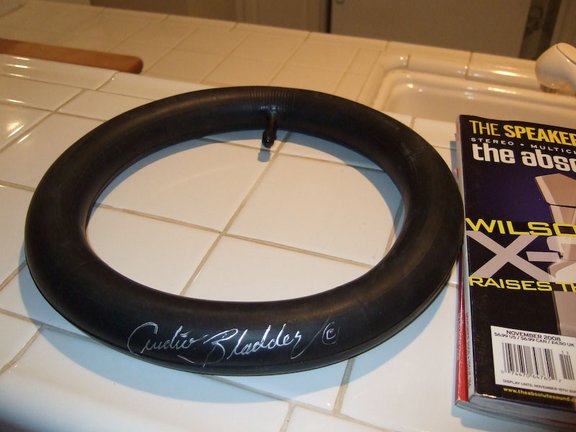
On top of the plywood board, place a 25mm or 1" marble or ball bearing into a concave plastic furniture cup.
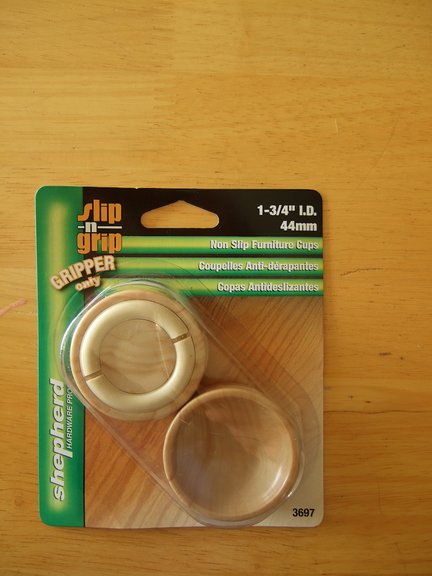
This is shown with wooden balls, but marbles or steel ball bearings are much better. You can use one or two cups per ball depending on what is required to raise the stock TT feet off the shelf.
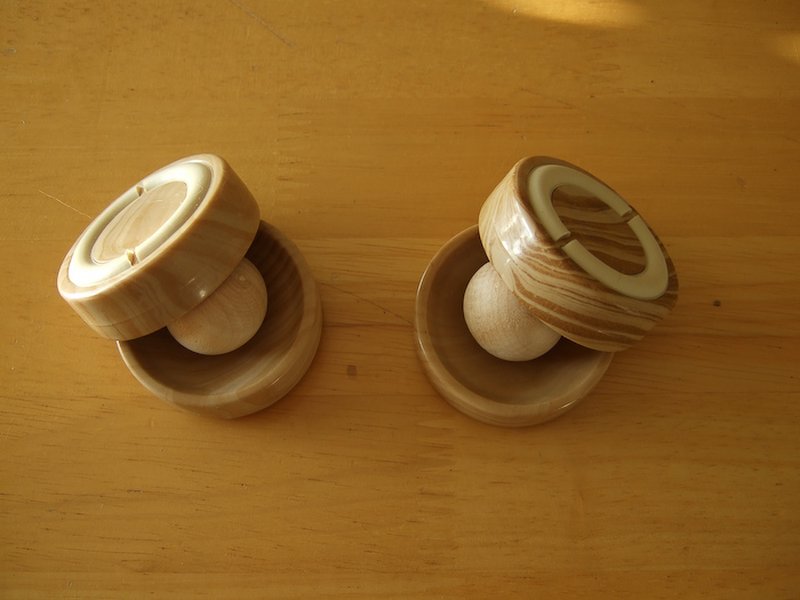
Use three of these under your turntable so that there is no possibilty of rocking or wobble (you can't rock a tripod). These will act as "roller blocks" and isolate your TT from seismic rotational and horizontal resonances.
The inner tube under the board acts as a low pass filter for vertical seismic resonances in the 3-15 Hz range. Using both together will provide a marked improvement in the sound from your TT in all regards: air, open-ness, transparency, imaging, detail, etc.
Here you can see the inner tube under a 1" maple board and the homemade roller blocks under my Rega.
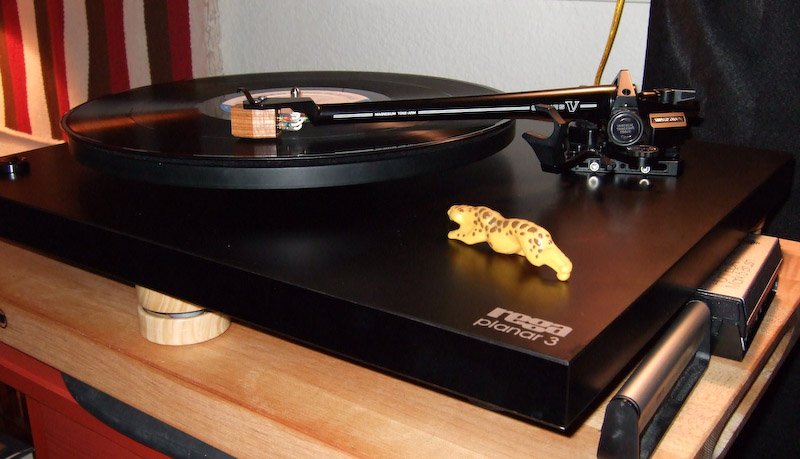
You should also put this setup under your amp, preamp, integrated for even more improvements. The improvements this will make in your system is NOT subtle.
Here is a shot showing this setup under my Conrad-Johnson Premier 11A power amp.
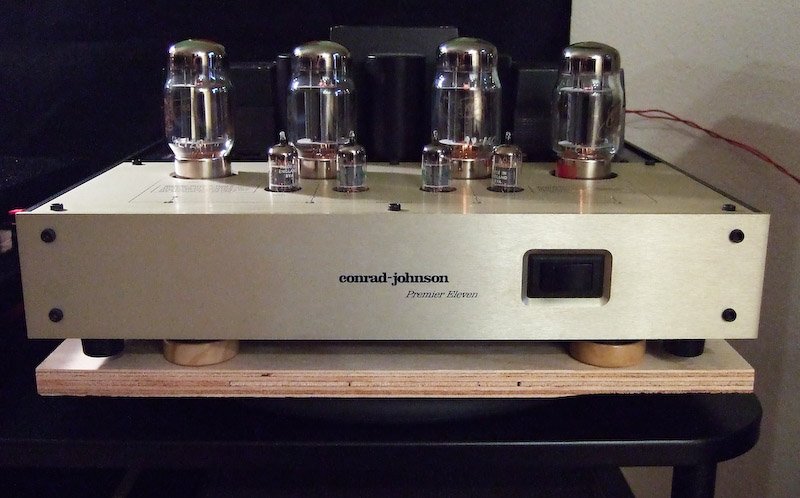
Search in the Steve Hoffman audio hardware forum for "inner tube", "Barry Diament" for many, many examples and much discussion of this technique.
High mass boards, blocks, cement or marble blocks, sand boxes are NOT, I repeat, NOT the way to go for turntable isolation. You're just raising the amount of resonating mass that needs isolation. All the folks who specialize in professional isolation products agree with this. A light rigid board resting on an inner tube is a MUCH better bet, or a shelf that is of the floor.
Try this: get 3/4" or 1" plywood board cut from scrap to be slightly larger than your TT.
Set this board on an 12" or 16" inner tube inflated just enough to support the board and your TT, off the shelf, this will be around 10 PSI. Put a straw under the inner tube so that it does not seal against the board from vacuum and cause a mid-bass hump.

On top of the plywood board, place a 25mm or 1" marble or ball bearing into a concave plastic furniture cup.

This is shown with wooden balls, but marbles or steel ball bearings are much better. You can use one or two cups per ball depending on what is required to raise the stock TT feet off the shelf.

Use three of these under your turntable so that there is no possibilty of rocking or wobble (you can't rock a tripod). These will act as "roller blocks" and isolate your TT from seismic rotational and horizontal resonances.
The inner tube under the board acts as a low pass filter for vertical seismic resonances in the 3-15 Hz range. Using both together will provide a marked improvement in the sound from your TT in all regards: air, open-ness, transparency, imaging, detail, etc.
Here you can see the inner tube under a 1" maple board and the homemade roller blocks under my Rega.

You should also put this setup under your amp, preamp, integrated for even more improvements. The improvements this will make in your system is NOT subtle.
Here is a shot showing this setup under my Conrad-Johnson Premier 11A power amp.

Search in the Steve Hoffman audio hardware forum for "inner tube", "Barry Diament" for many, many examples and much discussion of this technique.
Last edited:
Balifly
Listening
My apology
Oops, I had no intension of giving BAD advice.
Here goes my disclaimer:
The use of marble board for purposes other than food preparation has not been scientifically test. Use it at your own risk. :nono:
I humbly apologize to any one that I had inadvertently led astray-ed.
Oops, I had no intension of giving BAD advice.
Here goes my disclaimer:
The use of marble board for purposes other than food preparation has not been scientifically test. Use it at your own risk. :nono:
I humbly apologize to any one that I had inadvertently led astray-ed.
bobforapples
Angular banjos sound good
I saw a neat design with a box full of sand and glass on top. The turntable sits on the glass and any vibration would actually be soaked up in the voids amongst the sand.
I almost tried it, but, I saw sand getting everywhere and I don't really see a point to it anyways !!!
!!!
I almost tried it, but, I saw sand getting everywhere and I don't really see a point to it anyways
Aaaaah Isolation Platforms. :scratch2:
How far do you want to take this idea?
These are deep,deep waters.Rewards aplenty.The end result will be ultimately no better than the turntable(system)used....but given a very high quality turntable,the effort put in(or the money spent)will be repaid handsomely.
Consider that isolation can be applied either under the shelf that the turntable sits-on,between the turntable and the shelf and(here's a twist)between the LP and the platter.
Also consider the difference between 'Coupling' and Isolation'.The difference needs to be made clear in order for discussion to remain clear with regard to the topic being discussed.
Confusing the matter is the fact that most products isolate in some ways, and couple in others.For instance a 'rollerball' partially isolates in the horizontal plane,but couples in the vertical plane.They will work very,very well when mated with a vertical isolator.
Look at the example given of the inner tube/'roller-block' combination shown in the pictures posted earlier.The partially inflated inner-tube provides decent partial vertical isolation and the 'roller-balls' provide partial horizontal.These work quite well in practice,but can be tricky to implement.Components with wildly off-center weight distributions pose problems.Problems which directly affect the effectiveness of the principles acting to achieve the isolation.Actually(correctly)ameliorating those problems is not as simple a matter as 'getting it level'.There are resonant frequency interactions which limit the effective realisation of the principles which are at work in these systems.The result can be better than nothing(much better),but could be so much more effective if the system can be optimised.
Also consider that with mechanical contact systems like turntables,a certain amount of 'draining'/sinking of vibration onto compounds can be beneficial in combination with the isolation approach.
Experimentation is the order of the day.The results are very obvious,when the turntable system itself(include the software here)is of a high-order.I will also say that the better the rest of the system-chain is,the easier it is to see where progress is being made.That stands to reason.
The conclusions which can be arrived at in this thread,could equally be applied(though implemented somewhat differently)to all the other components of the system.All the way to the speakers themselves.
There's a lot of room for sensible,rational discussion here folks.How far do you want to take it?
Let's hear someone else's thoughts on the matter at hand.The better your turntable is,the more this topic will reap dividends,though all would see some benefit.
This would make a good 'Sticky',as long as the thread remains focused on the task at hand.
How far do you want to take this idea?
These are deep,deep waters.Rewards aplenty.The end result will be ultimately no better than the turntable(system)used....but given a very high quality turntable,the effort put in(or the money spent)will be repaid handsomely.
Consider that isolation can be applied either under the shelf that the turntable sits-on,between the turntable and the shelf and(here's a twist)between the LP and the platter.
Also consider the difference between 'Coupling' and Isolation'.The difference needs to be made clear in order for discussion to remain clear with regard to the topic being discussed.
Confusing the matter is the fact that most products isolate in some ways, and couple in others.For instance a 'rollerball' partially isolates in the horizontal plane,but couples in the vertical plane.They will work very,very well when mated with a vertical isolator.
Look at the example given of the inner tube/'roller-block' combination shown in the pictures posted earlier.The partially inflated inner-tube provides decent partial vertical isolation and the 'roller-balls' provide partial horizontal.These work quite well in practice,but can be tricky to implement.Components with wildly off-center weight distributions pose problems.Problems which directly affect the effectiveness of the principles acting to achieve the isolation.Actually(correctly)ameliorating those problems is not as simple a matter as 'getting it level'.There are resonant frequency interactions which limit the effective realisation of the principles which are at work in these systems.The result can be better than nothing(much better),but could be so much more effective if the system can be optimised.
Also consider that with mechanical contact systems like turntables,a certain amount of 'draining'/sinking of vibration onto compounds can be beneficial in combination with the isolation approach.
Experimentation is the order of the day.The results are very obvious,when the turntable system itself(include the software here)is of a high-order.I will also say that the better the rest of the system-chain is,the easier it is to see where progress is being made.That stands to reason.
The conclusions which can be arrived at in this thread,could equally be applied(though implemented somewhat differently)to all the other components of the system.All the way to the speakers themselves.
There's a lot of room for sensible,rational discussion here folks.How far do you want to take it?
Let's hear someone else's thoughts on the matter at hand.The better your turntable is,the more this topic will reap dividends,though all would see some benefit.
This would make a good 'Sticky',as long as the thread remains focused on the task at hand.
Flammaster
DrumCorpsZappaFreak
I use a table for mine. 
dread31
Addicted Member
This has been discussed ad nauseum in the Steve Hoffman hardware forum.
High mass boards, blocks, cement or marble blocks, sand boxes are NOT, I repeat, NOT the way to go for turntable isolation. You're just raising the amount of resonating mass that needs isolation. All the folks who specialize in professional isolation products agree with this. A light rigid board resting on an inner tube is a MUCH better bet, or a shelf that is of the floor.
Try this: get 3/4" or 1" plywood board cut from scrap to be slightly larger than your TT.
Set this board on an 12" or 16" inner tube inflated just enough to support the board and your TT, off the shelf, this will be around 10 PSI. Put a straw under the inner tube so that it does not seal against the board from vacuum and cause a mid-bass hump.

On top of the plywood board, place a 25mm or 1" marble or ball bearing into a concave plastic furniture cup.

This is shown with wooden balls, but marbles or steel ball bearings are much better. You can use one or two cups per ball depending on what is required to raise the stock TT feet off the shelf.

Use three of these under your turntable so that there is no possibilty of rocking or wobble (you can't rock a tripod). These will act as "roller blocks" and isolate your TT from seismic rotational and horizontal resonances.
The inner tube under the board acts as a low pass filter for vertical seismic resonances in the 3-15 Hz range. Using both together will provide a marked improvement in the sound from your TT in all regards: air, open-ness, transparency, imaging, detail, etc.
Here you can see the inner tube under a 1" maple board and the homemade roller blocks under my Rega.

You should also put this setup under your amp, preamp, integrated for even more improvements. The improvements this will make in your system is NOT subtle.
Here is a shot showing this setup under my Conrad-Johnson Premier 11A power amp.

Search in the Steve Hoffman audio hardware forum for "inner tube", "Barry Diament" for many, many examples and much discussion of this technique.
Sorry, but I tried this once.
How do you keep the board/gear from wobbling around on top of that innertube? Obviously, it works for you, or you wouldn't be doing it.
I found it isolated my turntable, but was just too mushy and wobbly for my tastes. Kind of like a car with bad shocks. My current set-up seems to work wonderfully. I can rap on the stand pretty hard, with the needle sitting in the groove and nothing, I mean nothing, comes through the speakers.
I'm not trying to be argumentative (sp?) but that has been my experience.
Dave

